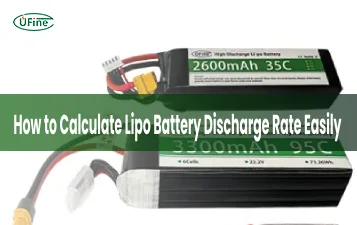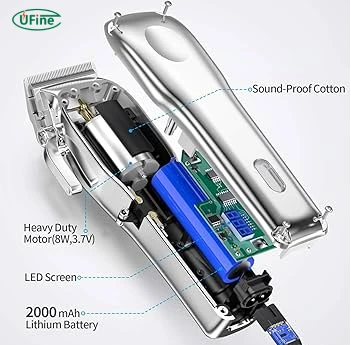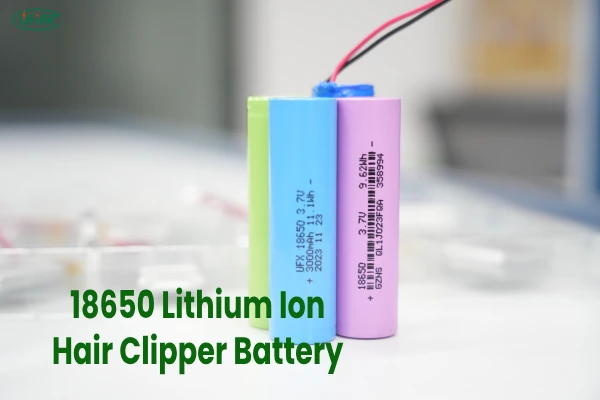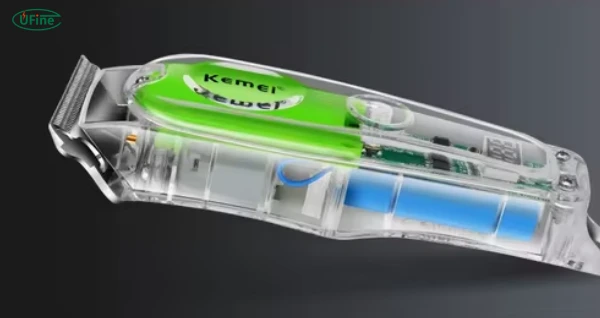If you’ve ever picked up your trimmer only to find it dead just when you needed it, you’re not alone. A hair clipper battery is the heart of your grooming device, and when it fails, it can be a frustrating experience. But here’s the good news: with a bit of knowledge and the right care, you can significantly extend the lifespan of your trimmer’s battery—and make the most of your grooming investment.
Let’s explore the key elements that determine how long a hair trimmer battery lasts, how to take care of it properly, and what you can do when it’s time for a replacement.
Part 1. Comparing hair clipper battery types: which one do you have?
Before understanding how long your battery will last, it’s crucial to know what kind of battery your hair clipper uses. Here’s a comprehensive comparison of the main battery types:
1.1 Nickel-Cadmium (NiCd)
- Voltage: ~1.2V
- Lifespan: 500–1000 cycles
- Charge Time: 1–2 hours
- Memory Effect: Yes
- Weight: Heavy
- Pros: Cheap, durable in extreme temperatures
- Cons: Outdated, environmental hazard, loses capacity quickly if not discharged properly
1.2 Nickel-Metal Hydride (NiMH)
- Voltage: ~1.2V
- Lifespan: 500–1000 cycles
- Charge Time: 2–3 hours
- Memory Effect: Slight
- Weight: Medium
- Pros: Better than NiCd, more eco-friendly
- Cons: Slower charge, still suffers from gradual capacity loss
1.3 Lithium-Ion (Li-ion)
- Voltage: 3.6V–3.7V
- Lifespan: 800–1500 cycles
- Charge Time: 1–2 hours
- Memory Effect: No
- Weight: Light
- Pros: High energy density, fast charging, long lifespan
- Cons: Sensitive to heat, costlier than NiMH
1.4 Lithium-Polymer (LiPo)
- Voltage: 3.7V–4.2V
- Lifespan: 1000–1500+ cycles
- Charge Time: 1–1.5 hours
- Weight: Ultra-light
- Pros: Flexible form factor, very light, excellent lifespan
- Cons: Expensive, requires protection circuits
1.5 LiFePO4 (Lithium Iron Phosphate)
- Voltage: 3.2V
- Lifespan: 1500–2000 cycles
- Charge Time: 1–2 hours
- Memory Effect: None
- Weight: Moderate
- Pros: Extremely stable, long life, safe
- Cons: Lower energy density than Li-ion or LiPo
1.6 Alkaline (Non-rechargeable)
- Voltage: 1.5V
- Lifespan: N/A
- Charge Time: Not applicable
- Pros: Disposable, easily available
- Cons: Not eco-friendly, expensive over time
1.7 Lead-Acid
- Voltage: ~2V
- Lifespan: 200–300 cycles
- Charge Time: 6–8 hours
- Pros: Inexpensive
- Cons: Bulky, rarely used in modern devices
Tip: Most modern cordless hair clippers now use Li-ion, LiPo, or even LiFePO4 batteries for their superior longevity, lighter weight, and safety.
Part 2. Upgrade or replace with confidence – Choose Ufine Battery
When it’s time to replace your hair clipper battery, don’t settle for subpar power cells. Ufine Battery, a trusted Chinese custom lithium battery manufacturer, offers a full range of battery solutions tailored to your needs:
- Lithium Polymer Batteries
- LiFePO4 Batteries
- 18650 Cylindrical Cells
- Ultra-Thin, High-Rate, and High-Temperature Batteries
Whether you need a unique voltage, custom size, higher discharge rate, or enhanced thermal resistance, Ufine Battery can deliver precision-engineered solutions.
Contact Ufine Battery today to customize the perfect lithium battery for your clipper or grooming device. Power your product with confidence and quality!
Part 3. What affects the life of hair clipper batteries?
A battery’s lifespan is not just about its chemistry. How you use, charge, and store it matters deeply. Some of the most common factors that impact battery life include:
- Charging Habits: Overcharging or letting the battery fully drain regularly can drastically reduce its life.
- Heat Exposure: Leaving the trimmer in a hot bathroom or under sunlight can cause the battery to degrade.
- Frequency of Use: Using the trimmer daily means more charge cycles, which shortens battery life.
- Motor Load: Powerful motors drain the battery faster, especially if the blades are dull or clogged.
- Storage: Batteries left idle for months can lose capacity if stored either fully charged or completely empty.
- Maintenance: Hair build-up or oil residue can force the motor to work harder, draining the battery faster.
Nickel Cadmium VS. Nickel Metal Hydride Battery
Part 4. How long does a hair clipper battery last?
On average:
- NiMH/NiCd: 1–2 years
- Li-ion/LiPo: 3–5 years
- LiFePO4: Up to 7 years or more
How to Calculate Battery Life
Let’s say your trimmer uses a Li-ion battery rated for 1200 charge cycles. If you charge it twice a week:
Battery Life = 1200 / (2 × 52) = ~11.5 years
However, in real life, factors like heat, improper charging, and heavy use reduce this number. A realistic lifespan is 3–5 years for most lithium-based clipper batteries.
Part 5. How to extend the life of a hair clipper battery
Imagine getting several extra years out of your clipper just by changing a few habits. Here are actionable tips:
- Avoid Full Discharges: For lithium batteries, recharge before they drop below 20%.
- Don’t Leave It Plugged In Overnight: Overcharging wears down the cells.
- Use the Right Charger: Mismatched voltages or cheap chargers can damage the battery.
- Clean the Blades and Housing Regularly: A cleaner motor uses less power.
- Oil Moving Parts: This reduces strain on the motor, saving battery energy.
- Store at Room Temperature: Avoid damp or hot areas like bathrooms.
- Unplug When Not in Use: Avoid trickle charging or standby drain.
Part 6. Signs your hair clipper battery is dying
It’s easy to miss the early warning signs until it’s too late. Watch out for:
- The clipper runs out of power much faster
- Charging takes longer than usual
- The trimmer gets warm or hot during charging or use
- LED indicators behave abnormally
- The motor sounds weak or inconsistent
- Physical swelling or bulging near the battery
Part 7. Charging mistakes that shorten battery life
Avoid these battery-killers:
- Leaving it on the charger all the time
- Charging right after use when it’s hot
- Using fast chargers not meant for your device
- Letting it die to 0% every time
- Charging in high humidity environments
Part 8. Best charging schedules for hair clipper batteries
Whether you’re a professional barber or an occasional user, the right charging schedule makes a big difference:
- Charge before hitting 20%
- Unplug after 80–90%
- Don’t “top off” repeatedly
- Avoid charging multiple times a day
For NiMH/NiCd, it’s okay to fully discharge occasionally to avoid memory effect. For Li-ion and LiPo, partial charges are better.
Part 9. Cleaning and battery safety tips
Battery care isn’t just about charging. It’s also about safety:
- Always turn off the trimmer before cleaning
- Use a brush to remove hair from vents and blades
- Avoid water near the charging port
- Inspect battery area regularly for signs of wear or swelling
- Replace the battery if it leaks or becomes unusually hot
Part 10. FAQs
Can I replace the battery in my hair clipper
Yes, if it’s not sealed. Some models allow easy replacement, but others may need professional help or a custom battery like those from Ufine Battery.
Do some clippers use interchangeable battery packs?
Yes, professional clippers often have swappable lithium battery packs for longer use and less downtime.
Are dual-battery clippers better?
Yes. They typically last longer and provide more stable power, ideal for heavy or professional use.
Why doesn’t my new clipper battery last as long as claimed?
Real-world use, like thick hair or high speed, drains the battery faster than lab-tested specs suggest.
Can I upgrade to a higher capacity battery?
Yes, but only if it’s compatible. Custom battery packs from Ufine Battery can help ensure a safe upgrade.
Related Tags:
More Articles

LiPo Battery Discharge Rate Guide & Calculation Tips
Understand LiPo battery discharge rates, C-ratings, and how to calculate max current. Essential guide for RC, drones, and electronics users.
High‑Capacity 3S LiPo Batteries: 5000 mAh vs. 10000 mAh
Compare 3S LiPo 5000mAh vs 10000mAh batteries by weight, power, and use. Find the best fit for your drone, RC car, or boat setup.
Top 5 Applications for Small 3S LiPo Batteries
Small 3S LiPo batteries power drones, RC gear, wearables, and robotics with high energy and low weight. Making them ideal for compact electronics projects.
Building and Charging Your Own 3S LiPo Pack: A Step‑by‑Step Guide
Learn how to build, balance, and charge a 3S LiPo battery pack safely at home with this complete DIY guide for hobbyists and beginners.
How to Choose the Right LiPo Battery Plug Type?
Discover the best LiPo battery plug types, how to choose them, and expert tips for safe usage, soldering, and maintenance.






